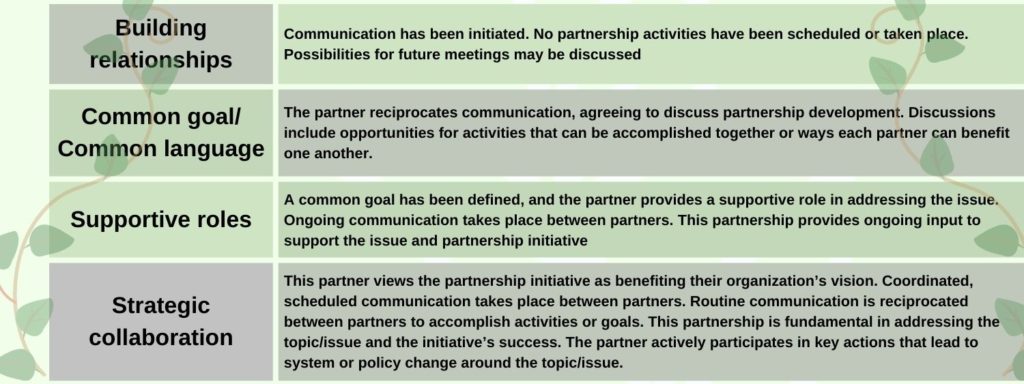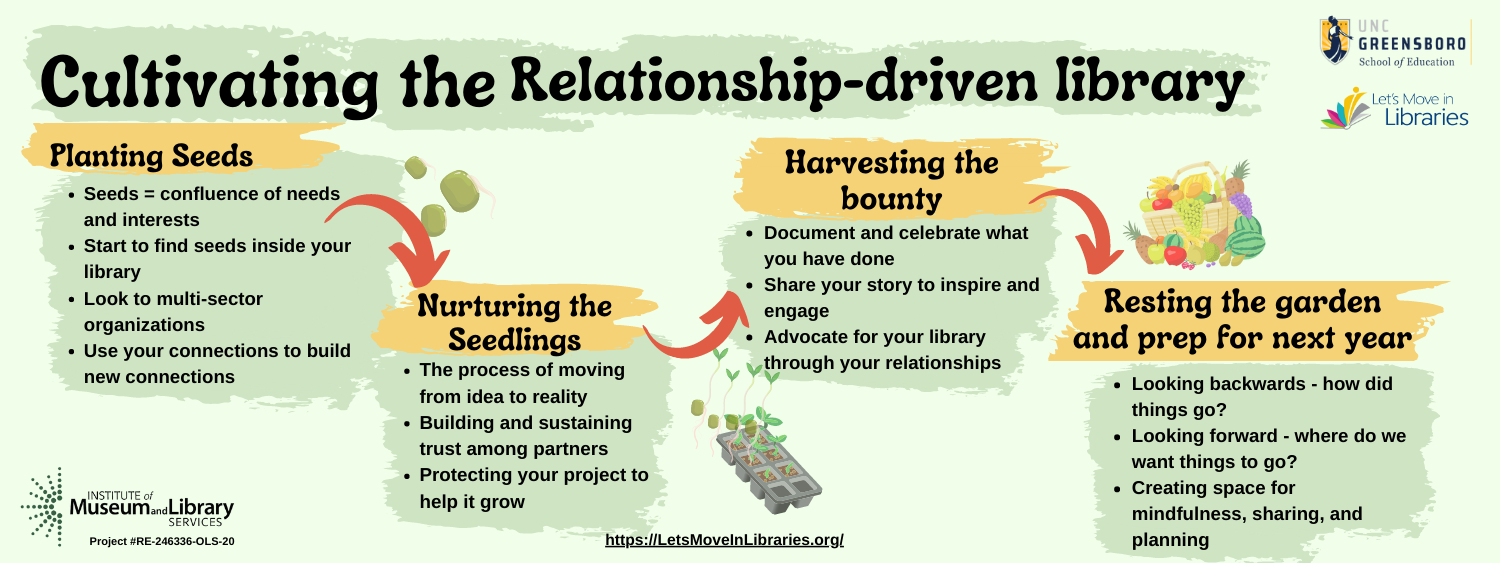Step 2 – Nurturing the seedlings
This step is all about nurturing the partnership seeds. It involves setting seedlings up for success, and nurturing them after they’re in the soil.
In other words, this step is about all the work you and your partners put in to bringing ideas into the world.
It takes time, energy, and attention to transform an idea into an impactful initiative. This step is focused on the work associated with tending to a seed, or idea, so that it can bloom and produce the sustenance you, your library, your partners, and your community needs.
Enjoy the journey as you’re on it! As Miriam Lytle of the Gail Borden Public Library District in Elgin, Illinois told us, “If you really have the right intention, of reaching deep into the community. And if you have an open hand to partnerships, it will be exponentially explosive, and powerful to a point that you can’t even imagine.”
Let’s unlock that potential by learning more about how to nurture our seedlings through our relationships.
The image below visually illustrates what this step entails as we seek to move from seeds to seedlings that have the potential to burst out of the soil and create something new and impactful in our community.

Don’t be the only one in the garden!
A key part of successfully nurturing your seedlings is ensuring you are not the only library person working on the idea.
Why?
More people from your library involve can help add more perspectives/ideas, which can lead to better collaborations. That increased library involvement can also plant more seeds for new programs/services and continued collaboration support.
Also invite members of your library board, your friends of the library, your volunteers, and whoever else is loosely affiliated with your library team to join you in nurturing your seedling. Their participation can help you increase support and advocacy for the seedling/idea.
Does it take time to build this institutional buy-in? Yes.
But without it you’ll be working on thin soil, and in that context your seedling could very easily blow away.
Give your idea a chance to establish roots by cultivating connections internally and externally around it.
Here’s an example: In Bethlehem, Pennsylvania library Josh Berk was invited to join a multi-sector effort to increase bicycle access in his city by making bicycles available for free check-out. The health department and a local hospital were part of the planning organization. Josh realized that for the library to successfully participate he’d need to get his team on board and excited, so he talked with the circulation manager and got her and her team excited and involved in the planning, so that the final check-out system would work for them, while also working for the community. Learn more at Bike Bethlehem and in our Bethlehem Area Public Library case study.
Setting up the seedlings
There are all kinds of ways to set your seeds up for success.
Some techniques we heard about include regular meetings among partners, working together towards milestones, drafting memoranda of understanding to get everyone on the same page, and, in some cases, just simply building up trust and mutual understanding among the partners so you don’t need to have anything super formal in place. As the director of the Community Services department in Pella, Iowa, told us, if she has an idea she’ll just go and share with the library staff, because over the years they’ve built up that sharing/collaborative culture.
The graphic below illustrates some of the ways librarians set their seedlings up for success when they plant them in communities. What techniques do you use? We’d love to hear from you and add your voice to this document!
Ultimately, different techniques are just means to an end, and that end is having a culture in place in which different organizations and individuals feel like they can talk openly about what’s working, what’s not working, and what they may need to do differently to to take great ideas and turn them into impactful realities.
Gardening tips:
Thinking about the list of options displayed in the settlings up seedlings graphic on your left, what techniques do you use in your library to nurture partnerships with outside organizations?
Do you find in your community things get done more through handshakes or more through written documentation? There is no right answer!
Navigating roles, in general
A great deal of practical advice focuses on the different types of partnerships that can exist across and between organizations. The figure below distills that wisdom.
In essence, this wisdom boils down to figuring out – with your partners – who is going to do what, when, and then having the trust in place so that everyone follows through (or can confidently update the group if their situation changes).
This step also involves inter-organizational coordination and trust.
- Does your partner work the same way you do? Probably not. How can you most effectively work with partners who don’t see things the same way you and your staff do?
- Examples from our research of coordination challenges and solutions.
The stage of nurturing the seedlings also involves figuring out what exactly your role is in the partnership and also what the roles of the partners are. Use the following four categories to get started defining for your community where you and your partners are at in terms of your partnership journey.

Navigating roles, in detail, or different strokes for different folks
To close out Step 2, we want to consider some of the detailed discussions you and your partners may have to have regarding roles, or who does what.
There is no one right way to set up and navigate the many different roles and relationships that together cultivate and grow seedlings.
That being said, considering these roles is critical because we found in our research that a stumbling block in many community partnerships centers around the navigation of roles among community partners.
For instance, one librarian told us that when she started representing the library in a community health coalition, “almost the whole first year, when we met I was asked to explain why the library was there. ‘What are you doing here? Like you’re not a member of the community care team?’ Those were not the words. It was that sort of questioning. To which I said, ‘Oh, uh, we are.’”
Part of navigating roles in asserting that library workers have a role in community-based work.
The images below illustrate what often happens.
People often ask librarians, “Can you distribute, market, or host something for me,” rather than asking “how can we work together.”

Similarly, librarians often feel they have to ask themselves “do I have the space, budget, or staff” to do this new initiative, rather than asking “who could I work with” to start this new initiative.
![]()
The work of nurturing seedlings with community partners can be a fraught process, full of landmines related to conceptions/stereotypes of libraries, librarians, and what it looks like to partner with a library.
To develop a seedling that is mutually beneficial for all partnerships, it is important for librarians to work hard, but it is also important to make sure that our labor is visible and appreciated.
Similarly, we want to work hard to make sure that all the contributions of our partners are seen and visible, appreciated and compensated (where necessary).
We will talk more about how to make this work visible in Step 3, which is focused on harvesting our bounty, or documenting and celebrating the fruits of our (collective) labor.
Here, though, the most important thing to keep in mind is transparency. Do you and your partners know what everyone is contributing? Do you and your partners have the resources they need to hold up your/their ends of the bargain? Do you and your partners have the trust needed to re-negotiate roles if something changes? Do and your partners have the open communication needed so that everyone feels like they have a voice in decisions related to planning, budget, and implementation?
Sometimes these conversations can go into complicated terrain, such as the topic of money.
- Many partners will willingly do the work for free, but sometimes offering to pay helps show value for their work and it can add motivation for the partner to continue to follow through on their commitments.
- Similarly, many libraries will willingly do the work for free, but sometimes the offer of payment to the library helps show value for your work and it can add motivation for the library to continue to follow through on its commitments to the partnership.
- There is no one right way to work collaboratively with your community. The key thing is to strive to have the trust, transparency, and communication needed to ensure there are no hidden agendas, invisible labor, or unsupported work.
Finally, these detailed discussions may also consider what each partner represents. In general, there are two types of partners: non-profits and for-profits.
Nonprofits/community organizations/city and county departments
- These organizations may often be able to work for free.
- Collaborations may involve supplementing what each department/organization has to offer to fill in gaps.
Local businesses
- We as library staff often may need to work harder to market the programs to help ensure bigger attendance/turnout, which helps spread the word about the business and increase their own sales, etc
- You and your library may approach partnerships with these different sectors in different ways.
Wrapping up
Navigating the many different ways that you and your library may find yourselves working collaboratively with partners is a complicated process. There is no one right way for library workers to collaborate with others to nurture seedlings, or to transform ideas into realities. Instead, there are multiple paths to success. We want to alert you to the different configurations that may be possible, so that you go into this process with your eyes open, and attuned to the possibilities.


